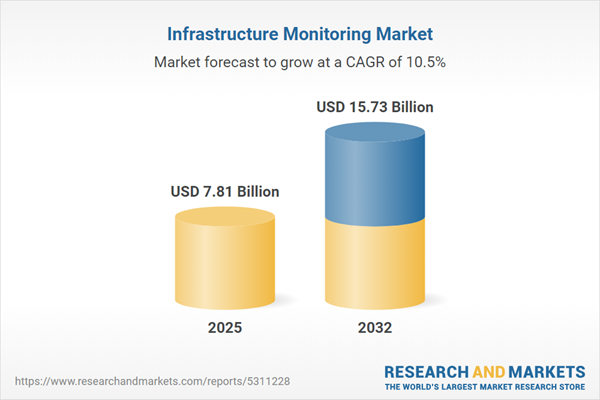Speak directly to the analyst to clarify any post sales queries you may have.
The infrastructure monitoring market is evolving rapidly as enterprises prioritize resilience, digital agility, and efficient asset management. As organizational IT ecosystems diversify with cloud, edge, and hybrid deployments, there is rising demand for integrated solutions that deliver comprehensive observability while managing operational complexity.
Market Snapshot: Infrastructure Monitoring Market Size and Growth
The Infrastructure Monitoring Market grew from USD 7.10 billion in 2024 to USD 7.81 billion in 2025. Sustained by increasing digital transformation initiatives and organizational focus on operational continuity, it is expected to continue growing at a CAGR of 10.46%, reaching USD 15.73 billion by 2032.
Scope & Segmentation
This report provides detailed coverage across solution types, components, technologies, end-user sectors, regions, and leading vendors shaping the infrastructure monitoring landscape.
- Type: Agent-Based Monitoring, Agentless Monitoring
- Component: Services (Managed, Professional); Solutions (Application Performance Monitoring (APM), Cloud Monitoring, Database Monitoring, Network Monitoring, Server Monitoring, Storage Monitoring)
- Technology: Wired, Wireless
- End-User Vertical: Aerospace & Defense, Automotive, Construction, Manufacturing, Oil & Gas, Power Generation
- Geography: Americas (United States, Canada, Mexico, Brazil, Argentina, Chile, Colombia, Peru), Europe (United Kingdom, Germany, France, Russia, Italy, Spain, Netherlands, Sweden, Poland, Switzerland), Middle East (United Arab Emirates, Saudi Arabia, Qatar, Turkey, Israel), Africa (South Africa, Nigeria, Egypt, Kenya), Asia-Pacific (China, India, Japan, Australia, South Korea, Indonesia, Thailand, Malaysia, Singapore, Taiwan)
- Vendors: Auvik Networks Inc., BMC Software, Inc., Broadcom, Inc., Cisco Systems, Inc., Datadog, Dynatrace Inc., eG Innovations, Grafana Labs, Hewlett Packard Enterprise Company, Icinga GmbH, International Business Machines Corporation, Kentik, Inc., LogicMonitor Inc., Microsoft Corporation, Nagios Enterprises, LLC, NEW RELIC INC., Opsview Ltd., Paessler GmbH, Progress Software Corporation, Prometheus by The Linux Foundation, ScienceLogic, Inc., SolarWinds Worldwide, LLC, Splunk LLC, Sumo Logic, Inc., Zabbix LLC, Zoho Corporation Pvt. Ltd.
Key Takeaways for Senior Decision-Makers
- Integrating infrastructure monitoring platforms supports operational continuity by aligning real-time observability with evolving digital environments and risk management imperatives.
- Advanced solutions leverage artificial intelligence and machine learning to detect anomalies earlier and automate incident resolution, elevating proactive risk mitigation across distributed assets.
- Market segmentation reveals agent-based monitoring enables deep visibility, while agentless approaches streamline deployment in cloud and hybrid settings, allowing organizations to adopt flexible, hybrid frameworks as needed.
- The convergence of operational technology (OT) and IT ecosystems increasingly demands unified monitoring frameworks that address cross-domain telemetry and sector-specific compliance requirements.
- Vendor ecosystems are expanding through platform interoperability, including open APIs and alliances with adjacent toolchains, reducing operational silos and simplifying vendor management.
Tariff Impact on Infrastructure Monitoring Supply Chains
Recent United States tariffs have introduced significant complexity in sourcing and cost structures, particularly for hardware components like network probes and storage appliances. These changes are prompting organizations to adjust procurement models and consider cloud-based service adoption for cost efficiency. Software vendors are also reassessing distribution strategies in response to fluctuating tariffs and currency valuations, reinforcing supply chain resilience and operational agility.
Methodology & Data Sources
This report utilizes a rigorous mixed-method research approach. In-depth interviews with senior executives and technical experts, quantitative surveys across industry verticals, and comprehensive secondary research from industry white papers and vendor documentation were synthesized. Statistical validation and scenario modeling ensure actionable, evidence-based insights for infrastructure monitoring strategies.
Why This Report Matters for Infrastructure Monitoring
- Enables senior leadership to benchmark monitoring capabilities, evaluate proactive strategies, and prioritize investments according to operational and compliance requirements.
- Offers deep insights into emerging technology adoption, impact of global trade policies, and cross-industry best practices—supporting data-driven decision making.
- Provides clarity on regional market nuances, equipping organizations to plan tailored go-to-market strategies and align with evolving regulatory demands.
Conclusion
Infrastructure monitoring is at the core of adaptive, resilient enterprise operations. With the right research-driven strategies, organizations can unlock competitive advantages, sustain uptime, and navigate future technological disruptions confidently.
Additional Product Information:
- Purchase of this report includes 1 year online access with quarterly updates.
- This report can be updated on request. Please contact our Customer Experience team using the Ask a Question widget on our website.
Table of Contents
3. Executive Summary
4. Market Overview
7. Cumulative Impact of Artificial Intelligence 2025
List of Figures
Samples

LOADING...
Companies Mentioned
The key companies profiled in this Infrastructure Monitoring market report include:- Auvik Networks Inc.
- BMC Software, Inc.
- Broadcom, Inc.
- Cisco Systems, Inc.
- Datadog
- Dynatrace Inc.
- eG Innovations
- Grafana Labs
- Hewlett Packard Enterprise Company
- Icinga GmbH
- International Business Machines Corporation
- Kentik, Inc.
- LogicMonitor Inc.
- Microsoft Corporation
- Nagios Enterprises, LLC
- NEW RELIC INC.
- Opsview Ltd.
- Paessler GmbH
- Progress Software Corporation
- Prometheus by The Linux Foundation
- ScienceLogic, Inc.
- SolarWinds Worldwide, LLC
- Splunk LLC
- Sumo Logic, Inc.
- Zabbix LLC
- Zoho Corporation Pvt. Ltd.
Table Information
| Report Attribute | Details |
|---|---|
| No. of Pages | 197 |
| Published | October 2025 |
| Forecast Period | 2025 - 2032 |
| Estimated Market Value ( USD | $ 7.81 Billion |
| Forecasted Market Value ( USD | $ 15.73 Billion |
| Compound Annual Growth Rate | 10.4% |
| Regions Covered | Global |
| No. of Companies Mentioned | 27 |









